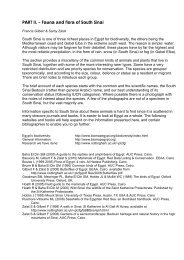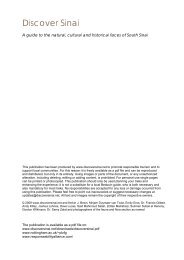Mt. Sinai (Jebel Musa) and the Safsafa basins - Discover Sinai
Mt. Sinai (Jebel Musa) and the Safsafa basins - Discover Sinai
Mt. Sinai (Jebel Musa) and the Safsafa basins - Discover Sinai
Create successful ePaper yourself
Turn your PDF publications into a flip-book with our unique Google optimized e-Paper software.
around <strong>the</strong> top end of <strong>the</strong> garden. To <strong>the</strong> west a long steep gully leadsup to a narrow saddle between two peaks. From <strong>the</strong> saddle <strong>the</strong>re is adramatic view on <strong>the</strong> plain of Wadi Raha. Getting to <strong>the</strong> peaks mightlook a bit scary as from <strong>the</strong> saddle you have to climb up steep smoothsurfaces above sheer drops. From <strong>the</strong> north peak you could comedown a different way <strong>and</strong> enter a gully below <strong>the</strong> garden. From thisgully you could get <strong>the</strong> same view as from <strong>the</strong> look-out point marked on<strong>the</strong> map – <strong>the</strong> two gullies actually join fur<strong>the</strong>r below <strong>and</strong> both are part ofWadi Shaby. To get back to <strong>the</strong> main path <strong>the</strong>re are two ways: youcould ei<strong>the</strong>r go back to <strong>the</strong> garden in Farsh <strong>Safsafa</strong> <strong>and</strong> climb over asmall hill at <strong>the</strong> corner of <strong>the</strong> garden, or take a little wadi connecting <strong>the</strong>two gullies <strong>and</strong> reach <strong>the</strong> paved path at <strong>the</strong> sharp turn.The garden in Farsh <strong>Safsafa</strong> is not cultivated any more, still, it is a verygood example of <strong>the</strong> Byzantine gardening <strong>and</strong> water managementpractices. As almost always <strong>the</strong> case, <strong>the</strong> garden is located in <strong>the</strong>water’s course, protected from <strong>the</strong> occasional floods by a massive wallthat lets some water in at certain places <strong>and</strong> channels it to reservoirs,trees <strong>and</strong> a well. Excess water is let out at <strong>the</strong> bottom of <strong>the</strong> garden.The dry stone wall has to be very strong as even in a short outburst ofrain, with water ga<strong>the</strong>ring from a large surface area of naked granite,will finally run through a single basin or wadi with an enormous force.The main purposes of <strong>the</strong> wall is to retain <strong>the</strong> soil – thus called retainingwall – <strong>and</strong> to protect <strong>the</strong> garden from massive rocks coming with <strong>the</strong>floods. Buildings are always found at elevated points, within <strong>the</strong> gardenor outside. Wells can also be found inside or outside, ei<strong>the</strong>r dug in <strong>the</strong>wadi floor or in porous rock upstream from <strong>the</strong> garden. There wereoften water tanks built next to <strong>the</strong> wells, connected to stone channelsdelivering <strong>the</strong> water where it was needed. In <strong>the</strong> past shadoofs wereused to pull <strong>the</strong> water up, a wooden triangle with a pole attached to it.There is a wide variety of fruits grown in <strong>the</strong> region, many that cannotbe found anywhere else in Egypt. A few things have changed – plasticpipes <strong>and</strong> diesel pumps got introduced – but in essence <strong>the</strong> traditions,<strong>and</strong> <strong>the</strong> seeds, originally brought by <strong>the</strong> monks live on in <strong>the</strong> hundredsof Bedouin gardens found in <strong>the</strong> high mountains.21







